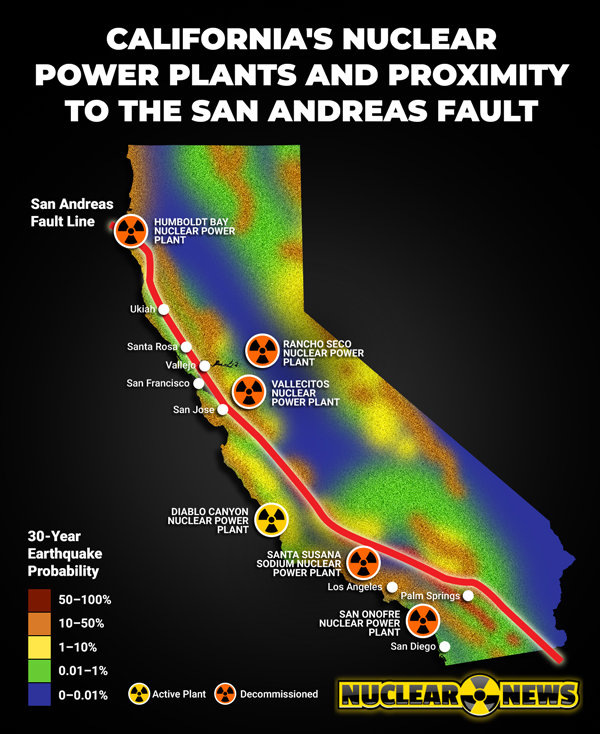A Natural News investigation into the geolocation of nuclear power facilities in California reveals that five nuclear facilities were built in close proximity to the San Andreas fault line, with some constructed right in the middle of earthquake zones that have up to a 50% chance of a severe earthquake every 30 years.
One nuclear power plant – the Diablo Canyon Nuclear Power Plant which produces 2,160 megawatts — was constructed on the coast, making it extremely vulnerable to the very same kind of ocean water surge that destroyed the Fukushima-Daiichi facility which suffered a 2011 meltdown in Japan. That nuclear catastrophe — which was dutifully covered up by the entire western media for months — was caused by an underwater earthquake that produced a tsunami wave which engulfed the facility. California’s Diablo Canyon Nuclear Power Plant is positioned on the coastline in the exact same way, making it highly vulnerable to underwater earthquakes or other events such as underwater caldera explosions that can produce massive tsunami waves.
There are five additional nuclear power facilities in California which are in various stages of being decommissioned, and many of them continues to store nuclear fuel on sight. Four of the five were constructed in close proximity to the San Andreas fault, with only one — the Rancho Seco Nuclear Power Plant — located in an area with a near-zero chance of an earthquake. The Humboldt Bay Nuclear Power Plant, located north of San Francisco, was constructed almost exactly on the San Andreas fault.
The following map, courtesy of Nuclear.news, overlays the locations of California’s nuclear power facilities compared to the San Andreas fault line:

With California now offering free health care to illegal aliens, the bankruptcy of the state seems inevitable. Who will fund the continued decommissioning of the nuclear fuel in California once public money runs out and the big infrastructure corporations are all bankrupt? The Diablo Canyon Nuclear Power Plant has been scheduled for decommissioning beginning in 2025, but will PG&E have any money left by then?
Cesium-137, one of the radioisotopes released in this type of accident, has a roughly 30-year half-life, meaning much of Southern California would be uninhabitable for 300 years (it requires ten half-lives to be considered gone). Imagine the logistics of attempting to evacuate Los Angeles, San Diego and San Francisco.
Even in nuclear facilities that are not currently active, the crumbling of storage pools and power plant walls could place nuclear fuel rods in fissionable proximity, resulting in a runaway fission event that leads to a meltdown. This might be even more difficult to control, given that these non-active nuclear power facilities don’t have full-time staff or, in some cases, even the equipment necessary to deal with a full-blown nuclear emergency.
In other words, even nuclear fuel rods currently kept in cold storage are not entirely safe from a powerful earthquake. It simply isn’t safe to store nuclear fuel anywhere near the San Andreas fault line… not under any conditions.
No comments:
Post a Comment